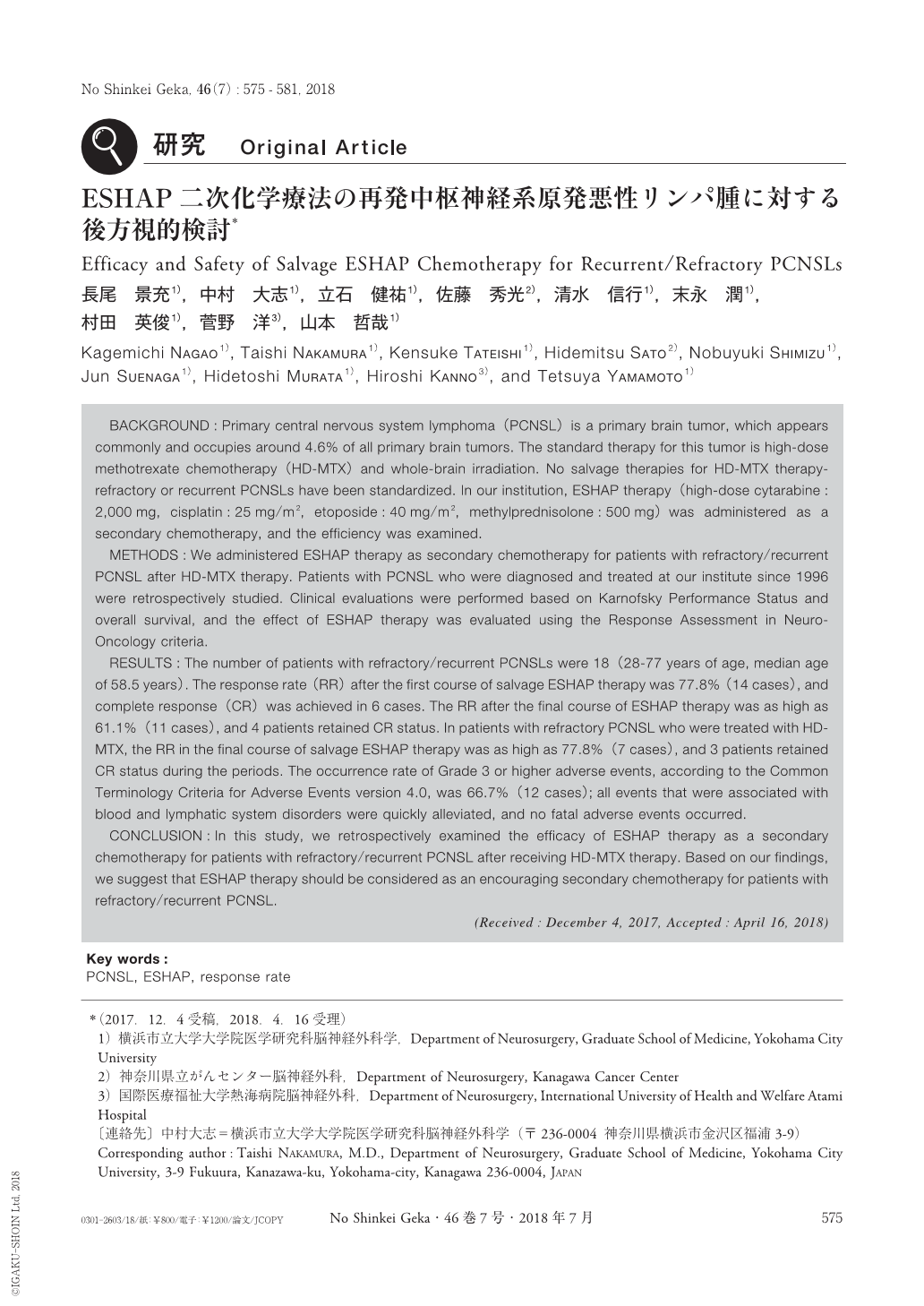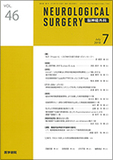Japanese
English
- 有料閲覧
- Abstract 文献概要
- 1ページ目 Look Inside
- 参考文献 Reference
Ⅰ.はじめに
中枢神経系原発悪性リンパ腫(primary central nervous system lymphoma:PCNSL)は,免疫不全を伴わない状態において中枢神経系組織に限局して発症したびまん性大細胞型B細胞リンパ腫(diffuse large B-cell lymphoma:DLBCL),と定義される14).PCNSLは全原発性脳腫瘍の4.6%を占め,その頻度は本邦を含む先進国において近年増加傾向にある13).標準治療として,生検による組織像の診断後に大量メトトレキサート(high-dose methotrexate:HD-MTX)を基盤とする化学療法を先行し,続いて全脳照射が施行されているものの,その予後は40〜55カ月と不良である10,13,15).また再発時における標準治療については未だ確立しておらず,現在さまざまな治療が試みられている.当院では,HD-MTX療法後の再発症例に対して,大量シタラビン(HD-AraC:2,000mg),シスプラチン(CDDP:25mg/m2),エトポシド(VP-16:40mg/m2),メチルプレドニゾロン(methylprednisolone:500mg)を用いた化学療法(以下,ESHAP療法)を施行している.今回われわれは,二次化学療法としてのESHAP療法の治療効果について検討を行った.
BACKGROUND:Primary central nervous system lymphoma(PCNSL)is a primary brain tumor, which appears commonly and occupies around 4.6% of all primary brain tumors. The standard therapy for this tumor is high-dose methotrexate chemotherapy(HD-MTX)and whole-brain irradiation. No salvage therapies for HD-MTX therapy-refractory or recurrent PCNSLs have been standardized. In our institution, ESHAP therapy(high-dose cytarabine:2,000mg, cisplatin:25mg/m2, etoposide:40mg/m2, methylprednisolone:500mg)was administered as a secondary chemotherapy, and the efficiency was examined.
METHODS:We administered ESHAP therapy as secondary chemotherapy for patients with refractory/recurrent PCNSL after HD-MTX therapy. Patients with PCNSL who were diagnosed and treated at our institute since 1996 were retrospectively studied. Clinical evaluations were performed based on Karnofsky Performance Status and overall survival, and the effect of ESHAP therapy was evaluated using the Response Assessment in Neuro-Oncology criteria.
RESULTS:The number of patients with refractory/recurrent PCNSLs were 18(28-77 years of age, median age of 58.5 years). The response rate(RR)after the first course of salvage ESHAP therapy was 77.8%(14 cases), and complete response(CR)was achieved in 6 cases. The RR after the final course of ESHAP therapy was as high as 61.1%(11 cases), and 4 patients retained CR status. In patients with refractory PCNSL who were treated with HD-MTX, the RR in the final course of salvage ESHAP therapy was as high as 77.8%(7 cases), and 3 patients retained CR status during the periods. The occurrence rate of Grade 3 or higher adverse events, according to the Common Terminology Criteria for Adverse Events version 4.0, was 66.7%(12 cases);all events that were associated with blood and lymphatic system disorders were quickly alleviated, and no fatal adverse events occurred.
CONCLUSION:In this study, we retrospectively examined the efficacy of ESHAP therapy as a secondary chemotherapy for patients with refractory/recurrent PCNSL after receiving HD-MTX therapy. Based on our findings, we suggest that ESHAP therapy should be considered as an encouraging secondary chemotherapy for patients with refractory/recurrent PCNSL.

Copyright © 2018, Igaku-Shoin Ltd. All rights reserved.


